Online Sparse Sensor Placement with Mobility Constraints for Pollution Plume Reconstruction
Abstract
1. Introduction
2. Methodology
2.1. Overall Framework and Principle
2.2. Incremental POD and QR Sensor Selection
2.3. Local QR-Based Sensor Selection with Mobility Constraints
- The sensor number constraint: ensures that the locations of the sensors are selected exactly p.
- Mobility constraint: Each new sensor location must be within a local neighborhood (with distance ) of a previous location , limiting how far a sensor can move between time steps.
- Minimum Separation Constraint: All selected sensor pairs must be at least distance apart to avoid spatial redundancy and ensure spatial diversity in observations.
| Algorithm 1: Local QR-based Sensor Selection with Mobility and Separation Constraints |
| Input: POD basis at time step k; previous sensor set ;candidate grid with coordinates ;number of sensors p; mobility limit ; minimum separation . |
| Output: Selected sensor set with . |
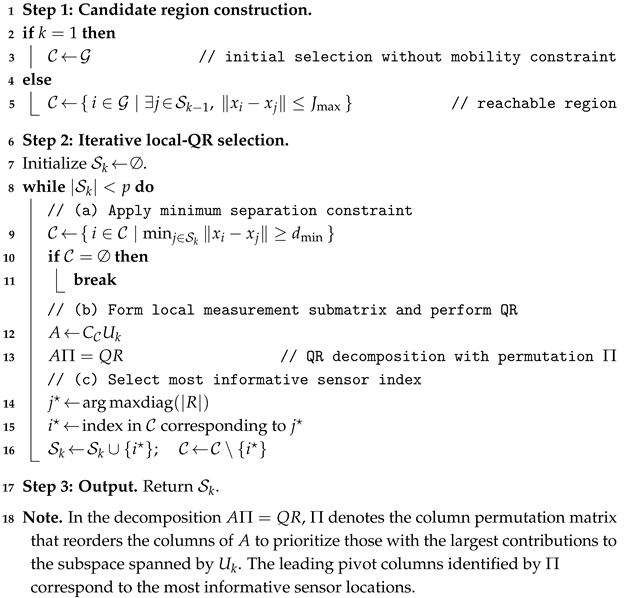 |
2.4. Datasets Description
2.4.1. An Analytical Solution with Three Point Sources
2.4.2. A Case Study on PM2.5 Emission in the United States
2.4.3. A Case Study on Side by Side Cylinders
2.5. Evaluation Metric
3. Experiments and Discussion
3.1. The Performance of Case1
3.2. The Performance of Case2
3.3. The Performance of Case3
3.4. Computational Cost and Scalability
- Overall trend with p. Across all panels, the Local–QR curves increase approximately monotonically with the number of sensors p; larger p yields longer per-step runtime. Moreover, the slope becomes markedly steeper as increases.
- Dominant role of . For a fixed p, raising from 10 to 100 to 1000 produces order-of-magnitude growth in per-step runtime (an upward shift on the log scale), indicating that the candidate-neighborhood radius is the primary computational lever.
- Minor impact of . Within each panel, the three Local–QR curves for nearly coincide, suggesting that the minimum separation mainly affects placement diversity and numerical stability rather than runtime.
- Comparison with Global–QR. The red baseline (Global–QR) is nearly flat across p and remains far below Local–QR, with the gap widening rapidly as grows: (i) : Local and Global are of the same order (tens of milliseconds), with Local slightly slower at larger p; (ii) : Local is roughly one order of magnitude slower; (iii) : Local reaches the ms range, substantially above Global.
3.5. Discussion
4. Conclusions and Remarks
Author Contributions
Funding
Data Availability Statement
Conflicts of Interest
References
- Mitchell, L.J.; Williamson, B.J.; Masden, E.A. Methods for highlighting ecological monitoring needs in data-sparse regions: A case study of impact assessment for multi-component infrastructure installations. Environ. Impact Assess. Rev. 2024, 105, 107433. [Google Scholar] [CrossRef]
- Masden, E.A.; McCluskie, A.; Owen, E.; Langston, R.H. Renewable energy developments in an uncertain world: The case of offshore wind and birds in the UK. Mar. Policy 2015, 51, 169–172. [Google Scholar] [CrossRef]
- Wayman, C.; Niemann, H. The fate of plastic in the ocean environment–a minireview. Environ. Sci. Process. Impacts 2021, 23, 198–212. [Google Scholar] [CrossRef]
- Brönmark, C.; Hansson, L.A. Environmental issues in lakes and ponds: Current state and perspectives. Environ. Conserv. 2002, 29, 290–307. [Google Scholar] [CrossRef]
- Tran-Nguyen, Q.A.; Le, T.M.; Nguyen, H.N.Y.; Nguyen, Q.T.; Trinh-Dang, M. Microplastics in the surface water of urban lakes in central Vietnam: Pollution level, characteristics, and ecological risk assessment. Case Stud. Chem. Environ. Eng. 2024, 9, 100622. [Google Scholar] [CrossRef]
- Yin, J.; He, B.; Fan, C.; Chen, R.; Zhang, H.; Zhang, Y. Drought-related wildfire accounts for one-third of the forest wildfires in subtropical China. Agric. For. Meteorol. 2024, 346, 109893. [Google Scholar] [CrossRef]
- Farid, A.; Alam, M.K.; Goli, V.S.N.S.; Akin, I.D.; Akinleye, T.; Chen, X.; Cheng, Q.; Cleall, P.; Cuomo, S.; Foresta, V.; et al. A Review of the Occurrence and Causes for Wildfires and Their Impacts on the Geoenvironment. Fire 2024, 7, 295. [Google Scholar] [CrossRef]
- Juwaied, A.; Jackowska-Strumillo, L. DL-HEED: A Deep Learning Approach to Energy-Efficient Clustering in Heterogeneous Wireless Sensor Networks. Appl. Sci. 2025, 15, 8996. [Google Scholar] [CrossRef]
- Stolkin, R.; Vickers, L.; Nickerson, J.V. Using environmental models to optimize sensor placement. IEEE Sens. J. 2007, 7, 319–320. [Google Scholar] [CrossRef]
- Bartolini, N.; Calamoneri, T.; Ciavarella, S.; Porta, T.L.; Silvestri, S. Autonomous mobile sensor placement in complex environments. ACM Trans. Auton. Adapt. Syst. (TAAS) 2017, 12, 1–28. [Google Scholar] [CrossRef]
- Sun, C.; Yu, Y.; Li, V.O.; Lam, J.C. Multi-type sensor placements in Gaussian spatial fields for environmental monitoring. Sensors 2019, 19, 189. [Google Scholar] [CrossRef]
- Nguyen, T.T.; Thanh, H.D.; Le, V.T. Optimization for the sensor placement problem in 3D environments. In Proceedings of the 2015 IEEE 12th International Conference on Networking, Sensing and Control, Taipei, Taiwan, 9–11 April 2015; IEEE: Piscataway, NJ, USA, 2015; pp. 327–333. [Google Scholar]
- Manohar, K.; Brunton, B.W.; Kutz, J.N.; Brunton, S.L. Data-driven sparse sensor placement for reconstruction: Demonstrating the benefits of exploiting known patterns. IEEE Control Syst. Mag. 2018, 38, 63–86. [Google Scholar]
- Williams, Z.; Soto Calvo, M.; Lee, H.S.; Aljber, M.; Jeong, J.S. A Low-Cost Autonomous Multi-Functional Buoy for Ocean Currents and Seawater Parameter Monitoring, and Particle Tracking. J. Mar. Sci. Eng. 2025, 13, 1629. [Google Scholar] [CrossRef]
- Riser, S.C.; Freeland, H.J.; Roemmich, D.; Wijffels, S.; Troisi, A.; Belbéoch, M.; Gilbert, D.; Xu, J.; Pouliquen, S.; Thresher, A.; et al. Fifteen years of ocean observations with the global Argo array. Nat. Clim. Chang. 2016, 6, 145–153. [Google Scholar] [CrossRef]
- Karnik, N.; Abdo, M.G.; Estrada-Perez, C.E.; Yoo, J.S.; Cogliati, J.J.; Skifton, R.S.; Calderoni, P.; Brunton, S.L.; Manohar, K. Constrained optimization of sensor placement for nuclear digital twins. IEEE Sens. J. 2024, 24, 15501–15516. [Google Scholar] [CrossRef]
- Yang, L.; Pang, Y.; He, X.; Wang, Y.; Kan, Z.; Song, X. An active learning-driven optimal sensor placement method considering sensor position distribution toward structural health monitoring. Struct. Multidiscip. Optim. 2024, 67, 1–23. [Google Scholar] [CrossRef]
- Hassani, S.; Dackermann, U. A systematic review of optimization algorithms for structural health monitoring and optimal sensor placement. Sensors 2023, 23, 3293. [Google Scholar] [CrossRef] [PubMed]
- Manohar, K.; Kutz, J.N.; Brunton, S.L. Optimal sensor and actuator selection using balanced model reduction. IEEE Trans. Autom. Control 2021, 67, 2108–2115. [Google Scholar] [CrossRef]
- Clark, E.; Askham, T.; Brunton, S.L.; Kutz, J.N. Greedy sensor placement with cost constraints. IEEE Sensors J. 2018, 19, 2642–2656. [Google Scholar] [CrossRef]
- Zhang, Q.; Wu, H.; Mei, X.; Han, D.; Marino, M.D.; Li, K.C.; Guo, S. A sparse sensor placement strategy based on information entropy and data reconstruction for ocean monitoring. IEEE Internet Things J. 2023, 10, 19681–19694. [Google Scholar] [CrossRef]
- Marcato, A.; Guiltinan, E.; Viswanathan, H.; O’Malley, D.; Lubbers, N.; Santos, J.E. Journey over destination: Dynamic sensor placement enhances generalization. Mach. Learn. Sci. Technol. 2024, 5, 025070. [Google Scholar] [CrossRef]
- Gao, H.; Hu, G.; Zhang, D.; Jiang, W.; Tse, K.; Noack, B.R. SiGAN: A 3D sensor importance deep generative model for urban wind flow field monitoring. Build. Environ. 2024, 262, 111787. [Google Scholar] [CrossRef]
- Andersson, T.R.; Bruinsma, W.P.; Markou, S.; Requeima, J.; Coca-Castro, A.; Vaughan, A.; Ellis, A.L.; Lazzara, M.A.; Jones, D.; Hosking, S.; et al. Environmental sensor placement with convolutional Gaussian neural processes. Environ. Data Sci. 2023, 2, e32. [Google Scholar] [CrossRef]
- Gao, H.; Liu, J.; Lin, P.; Hu, G.; Patruno, L.; Xiao, Y.; Tse, K.; Kwok, K. An optimal sensor placement scheme for wind flow and pressure field monitoring. Build. Environ. 2023, 244, 110803. [Google Scholar] [CrossRef]
- Wang, J.; Shen, T.; Zhao, D.; Zhang, F. MrDMD-Based Sensor Placement in Distributed Flow Estimation for the Design of the Artificial Lateral Line of an Underwater Robot. In Proceedings of the 2023 62nd IEEE Conference on Decision and Control (CDC), Singapore, 13–15 December 2023; IEEE: Piscataway, NJ, USA, 2023; pp. 4759–4765. [Google Scholar]
- Fareed, H.; Singler, J.R.; Zhang, Y.; Shen, J. Incremental proper orthogonal decomposition for PDE simulation data. Comput. Math. Appl. 2018, 75, 1942–1960. [Google Scholar] [CrossRef]
- Fischer, H.; Roth, J.; Wick, T.; Chamoin, L.; Fau, A. MORe DWR: Space-time goal-oriented error control for incremental POD-based ROM for time-averaged goal functionals. J. Comput. Phys. 2024, 504, 112863. [Google Scholar] [CrossRef]
- Feng, L.H.; Wang, J.J.; Pan, C. Proper orthogonal decomposition analysis of vortex dynamics of a circular cylinder under synthetic jet control. Phys. Fluids 2011, 23, 014106. [Google Scholar] [CrossRef]
- Ren, J.; Mao, X. Uncertainty transmission of fluid data upon proper orthogonal decompositions. Phys. Fluids 2023, 35, 071702. [Google Scholar] [CrossRef]
- Berkooz, G.; Holmes, P.; Lumley, J.L. The proper orthogonal decomposition in the analysis of turbulent flows. Annu. Rev. Fluid Mech. 1993, 25, 539–575. [Google Scholar] [CrossRef]
- Kim, Y.H. Greedy sensor selection based on QR factorization. EURASIP J. Adv. Signal Process. 2021, 2021, 1–13. [Google Scholar] [CrossRef]
- He, Q.; Tartakovsky, A.M. Physics-informed neural network method for forward and backward advection-dispersion equations. Water Resour. Res. 2021, 57, e2020WR029479. [Google Scholar] [CrossRef]
- Wang, C.; Wu, H.; Wang, N.; Ye, Z. A Novel Ship Fuel Sulfur Content Estimation Method Using Improved Gaussian Plume Model and Genetic Algorithms. J. Mar. Sci. Eng. 2025, 13, 690. [Google Scholar] [CrossRef]
- Meng, J.; Li, C.; Martin, R.V.; van Donkelaar, A.; Hystad, P.; Brauer, M. Estimated long-term (1981–2016) concentrations of ambient fine particulate matter across North America from chemical transport modeling, satellite remote sensing, and ground-based measurements. Environ. Sci. Technol. 2019, 53, 5071–5079. [Google Scholar] [CrossRef] [PubMed]
- Weymouth, G.D.; Font, B. WaterLily. jl: A differentiable and backend-agnostic Julia solver for incompressible viscous flow around dynamic bodies. Comput. Phys. Commun. 2025, 315, 109748. [Google Scholar] [CrossRef]
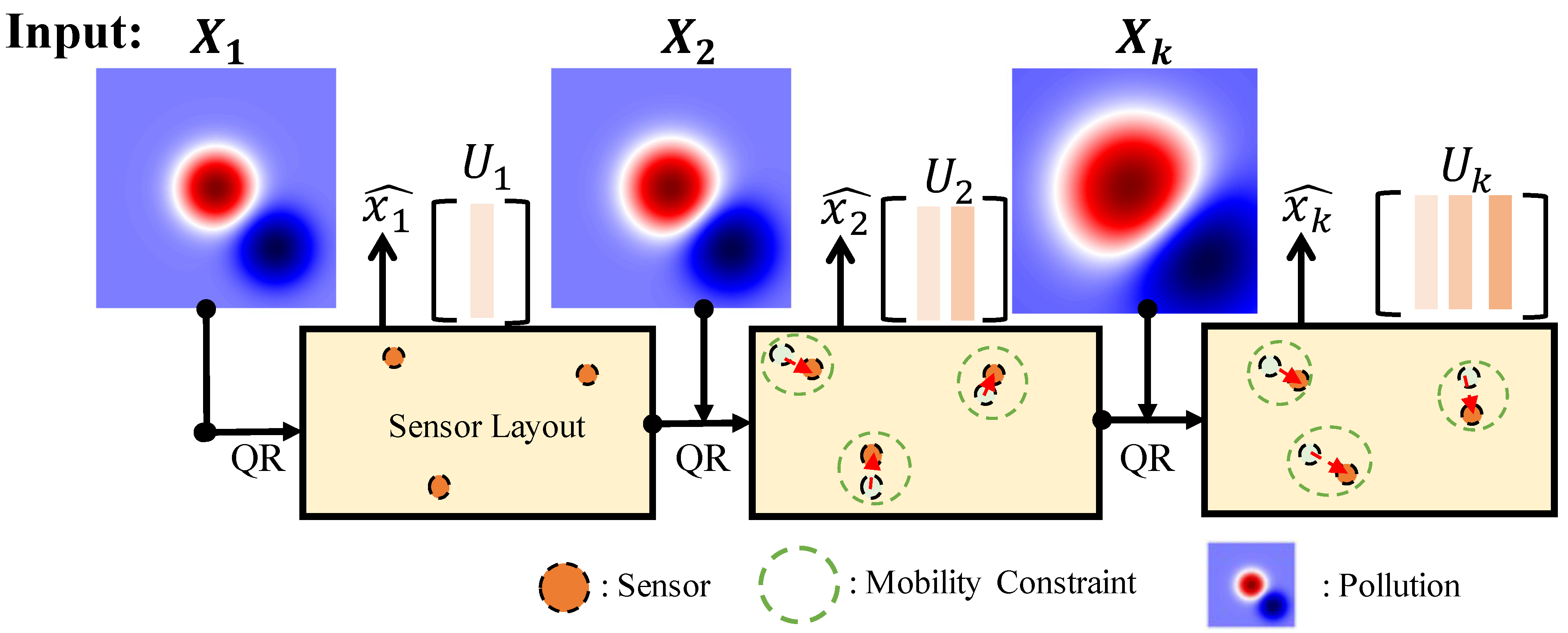



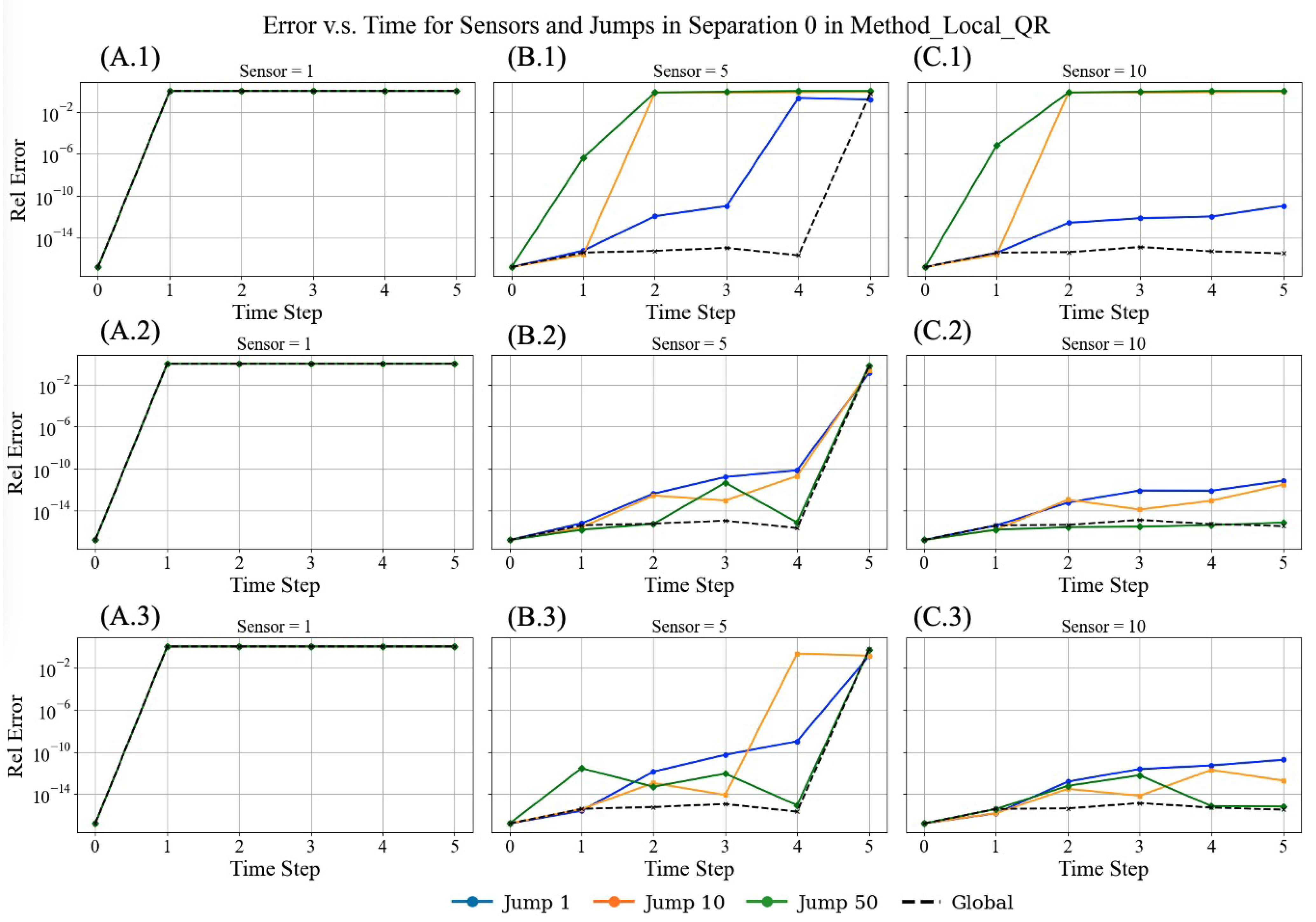
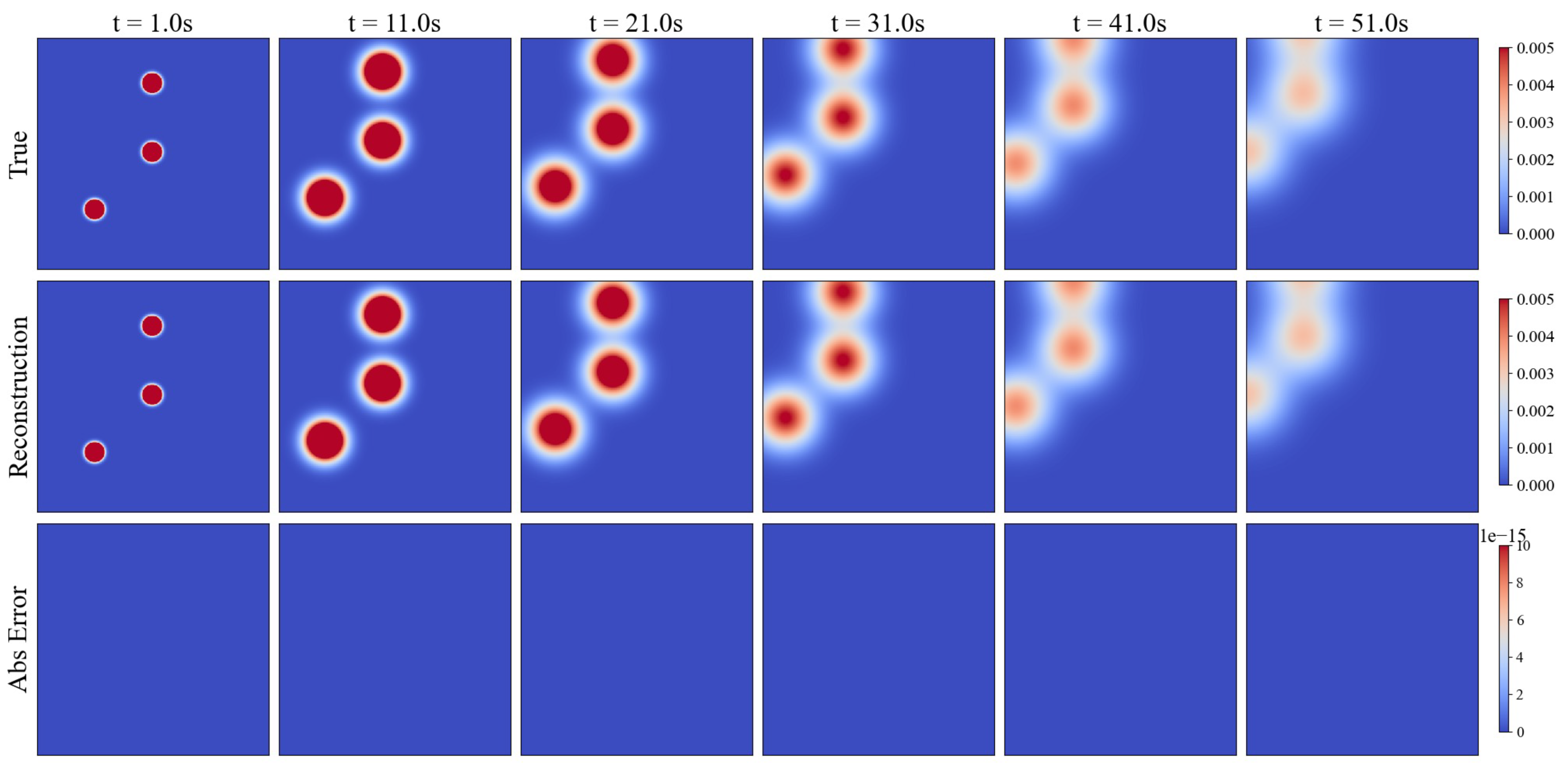

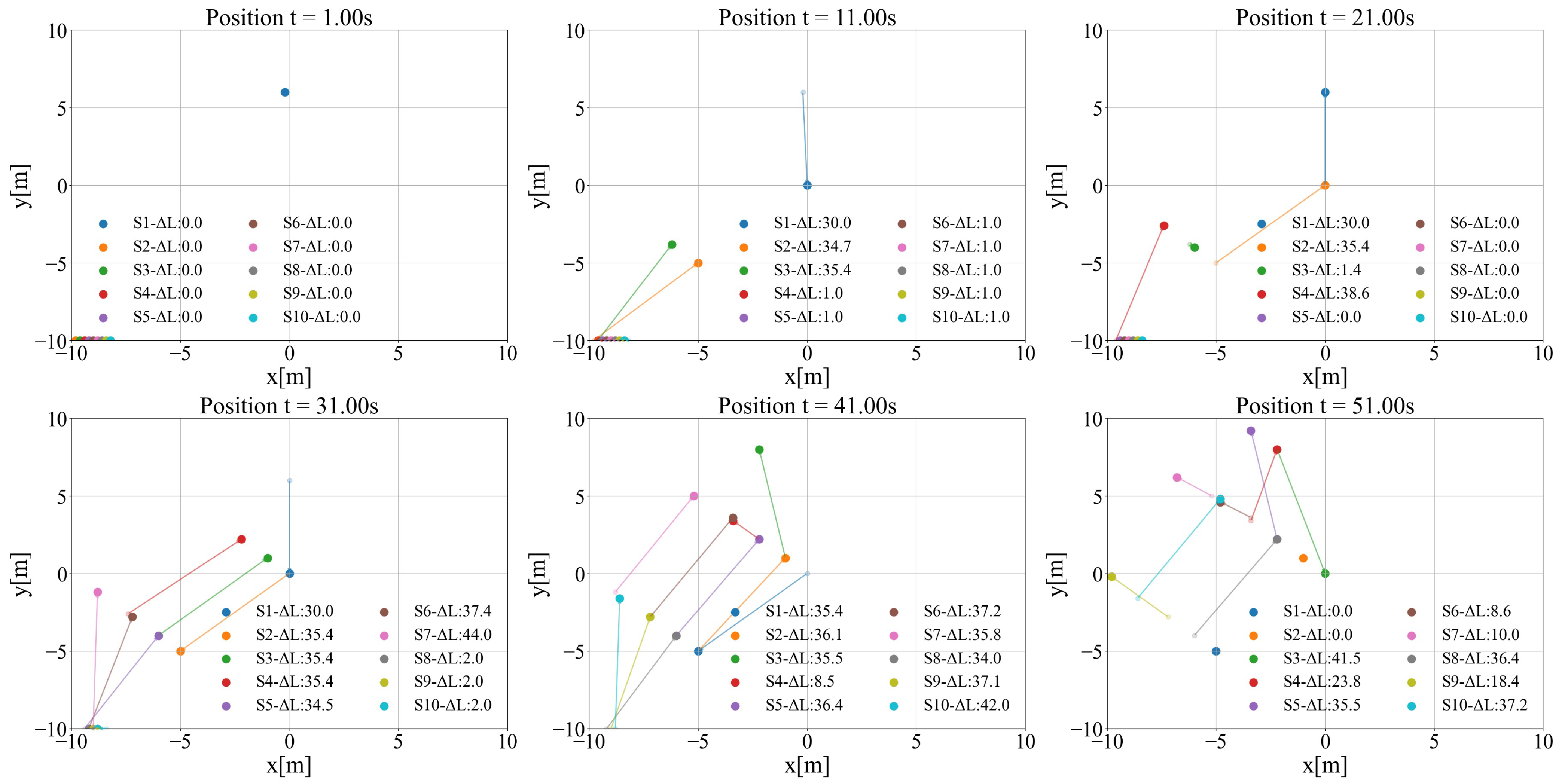
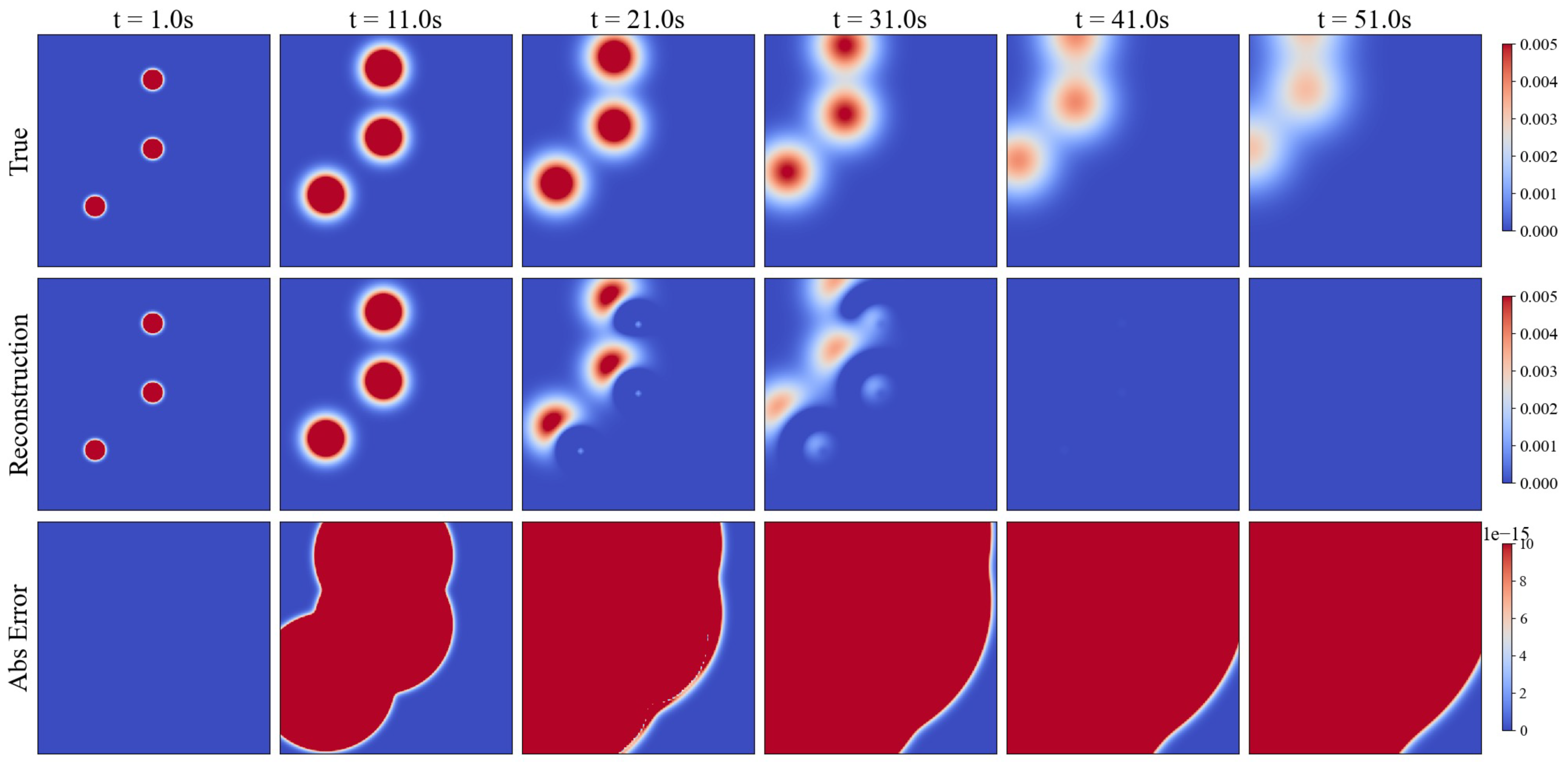
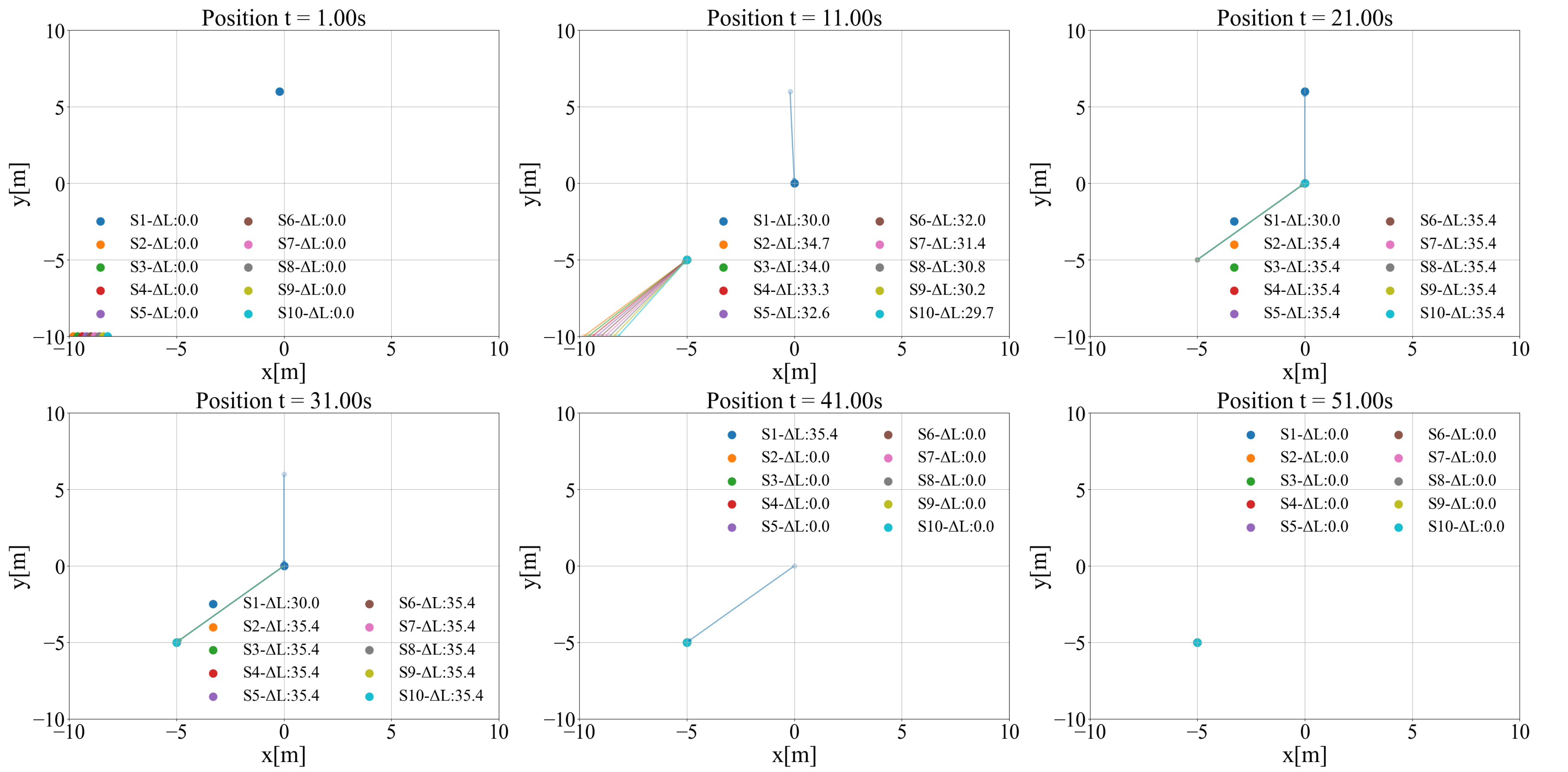

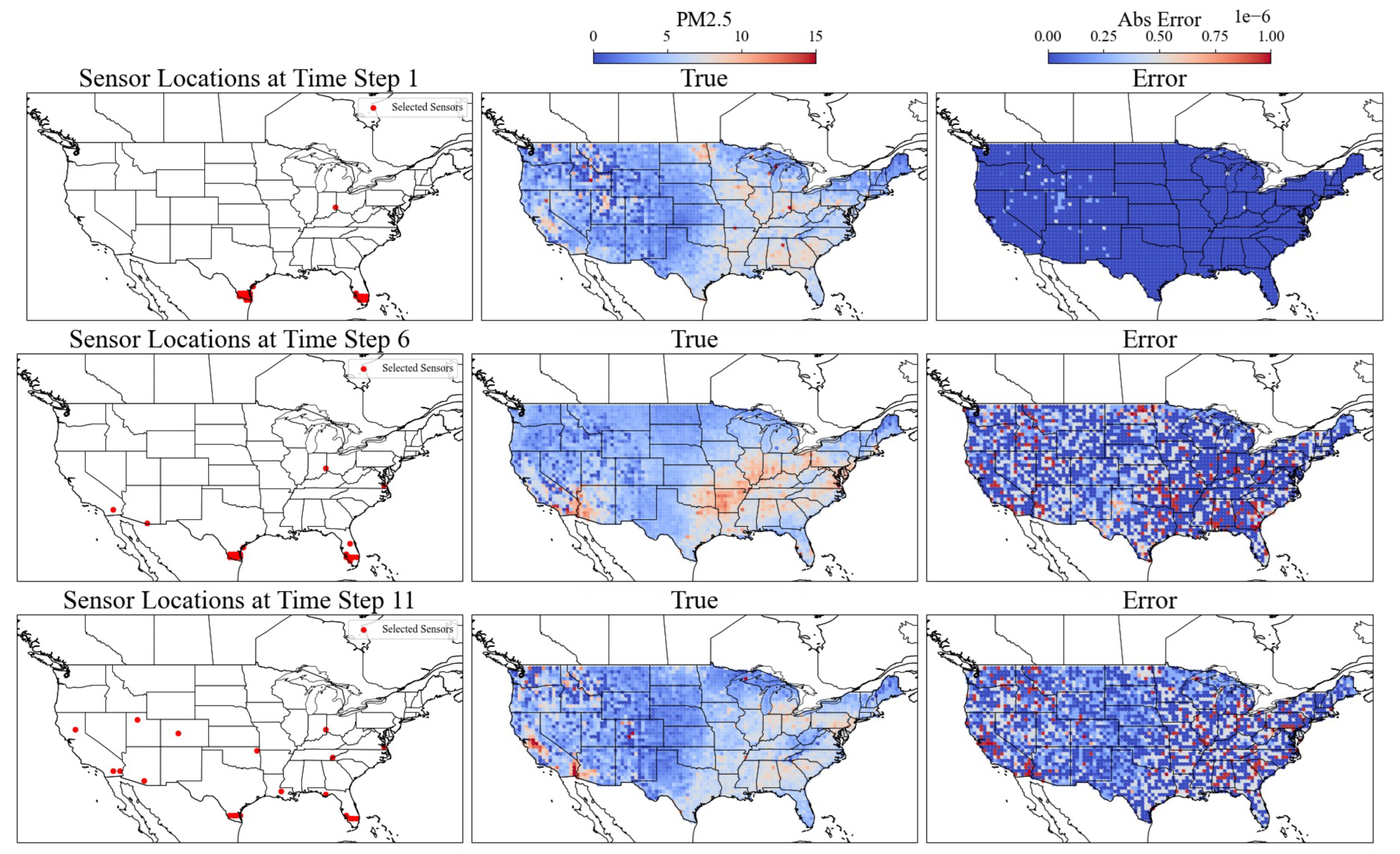


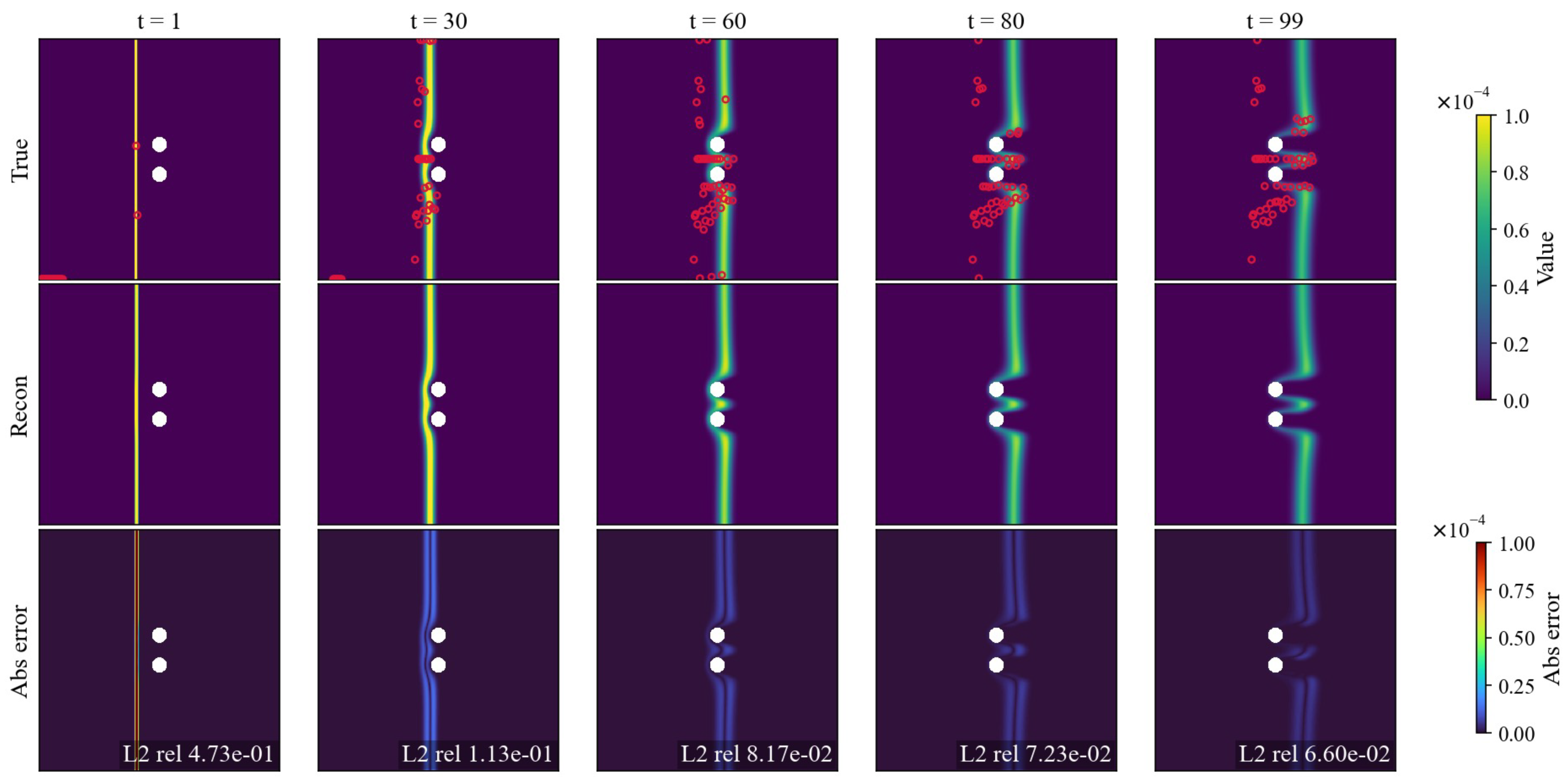
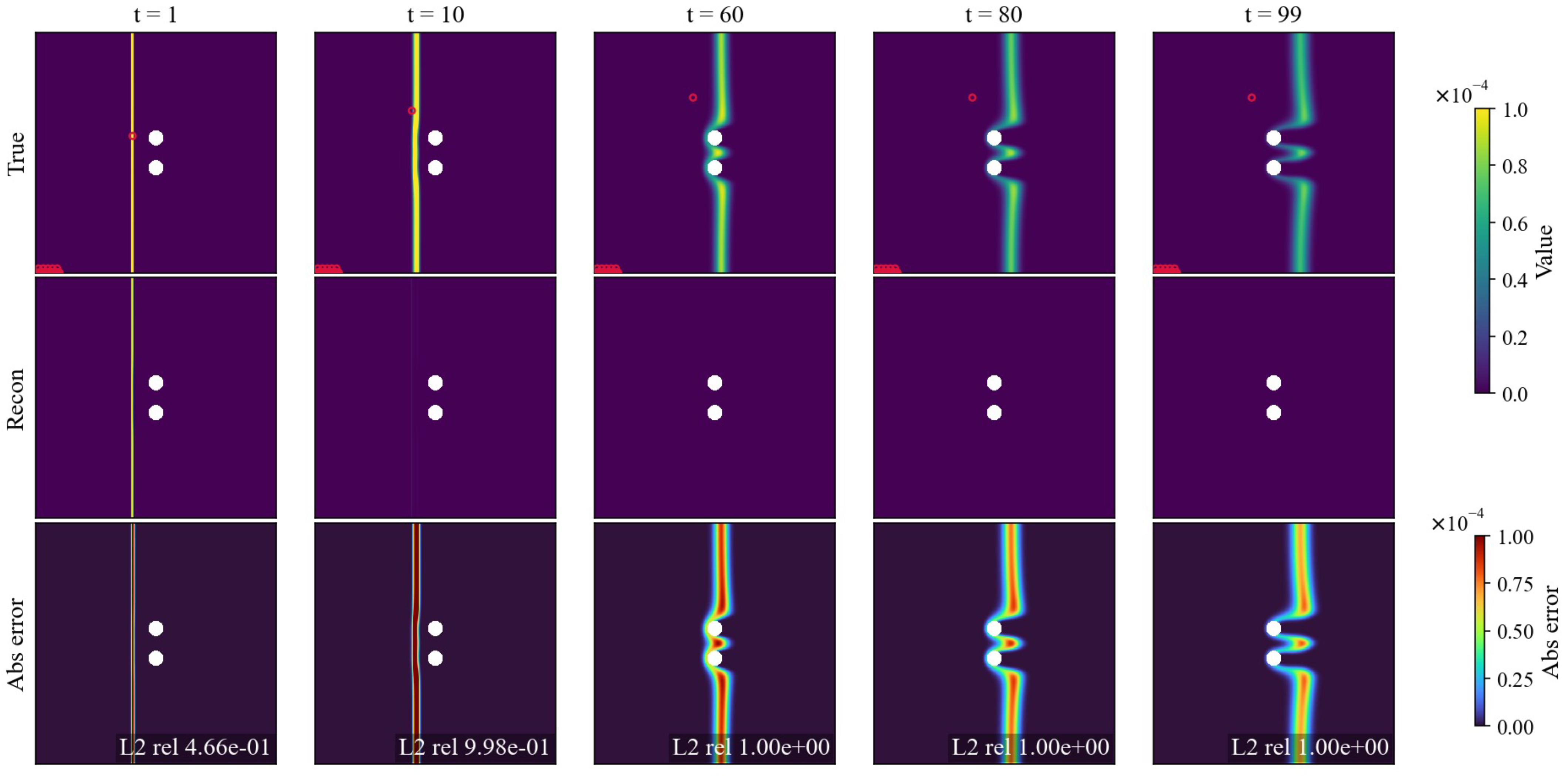

| Metric | Global QR | , | , |
|---|---|---|---|
| Condition Number at Time Step | |||
| 1.00 | 1.00 | 1.00 | |
| 2.99 | 4.24 | ||
| 3.90 | 5.52 | ||
| 4.41 | ∞ | 6.13 | |
| 4.37 | ∞ | 4.10 | |
| 4.29 | 5.89 | ||
| Sensor Movement Metrics (Grid Units) | |||
| 14.96 | 21.01 | 20.39 | |
| 84.74 | 35.36 | 41.48 | |
| Metric | Global QR | |||
|---|---|---|---|---|
| Condition Number at Time Step | ||||
| 0 | 1.00 | 1.00 | 1.00 | 1.00 |
| 1 | 1.73 | 1.58 | 1.69 | 2.78 |
| 2 | 2.45 | 1.40 | 1.66 | 30.6 |
| 3 | 2.90 | 1.70 | 1.62 | 6.94 × 1016 |
| 4 | 4.98 | 2.18 | 2.19 | 3.61 × 1016 |
| 5 | 5.40 | 2.59 | 2.56 | 9.93 × 1032 |
| 6 | 10.1 | 3.76 | 3.96 | 3.29 × 1033 |
| 7 | 12.2 | 3.81 | 4.57 | ∞ |
| 8 | 11.3 | 4.32 | 4.79 | ∞ |
| 9 | 11.4 | 4.88 | 4.54 | ∞ |
| 10 | 11.6 | 8.89 | 7.97 | ∞ |
| 11 | 987 | 698 | 879 | ∞ |
| Sensor Movement Metrics (km) | ||||
| 395.4 | 216.6 | 211.6 | 102.8 | |
| 3313.5 | 498.7 | 493.0 | 487.5 | |
| Metric | Global QR | , | , |
|---|---|---|---|
| Sensor Movement Metrics (Grid Units) | |||
| 47.0 | 28.14 | 62.26 | |
| 554.15 | 100 | 553 | |
Disclaimer/Publisher’s Note: The statements, opinions and data contained in all publications are solely those of the individual author(s) and contributor(s) and not of MDPI and/or the editor(s). MDPI and/or the editor(s) disclaim responsibility for any injury to people or property resulting from any ideas, methods, instructions or products referred to in the content. |
© 2025 by the authors. Licensee MDPI, Basel, Switzerland. This article is an open access article distributed under the terms and conditions of the Creative Commons Attribution (CC BY) license (https://creativecommons.org/licenses/by/4.0/).
Share and Cite
Liang, A.; Xu, D.; Chen, D.; Cui, W.; Liu, Q. Online Sparse Sensor Placement with Mobility Constraints for Pollution Plume Reconstruction. J. Mar. Sci. Eng. 2025, 13, 1995. https://doi.org/10.3390/jmse13101995
Liang A, Xu D, Chen D, Cui W, Liu Q. Online Sparse Sensor Placement with Mobility Constraints for Pollution Plume Reconstruction. Journal of Marine Science and Engineering. 2025; 13(10):1995. https://doi.org/10.3390/jmse13101995
Chicago/Turabian StyleLiang, Aoming, Duoxiang Xu, Dashuai Chen, Weicheng Cui, and Qi Liu. 2025. "Online Sparse Sensor Placement with Mobility Constraints for Pollution Plume Reconstruction" Journal of Marine Science and Engineering 13, no. 10: 1995. https://doi.org/10.3390/jmse13101995
APA StyleLiang, A., Xu, D., Chen, D., Cui, W., & Liu, Q. (2025). Online Sparse Sensor Placement with Mobility Constraints for Pollution Plume Reconstruction. Journal of Marine Science and Engineering, 13(10), 1995. https://doi.org/10.3390/jmse13101995







